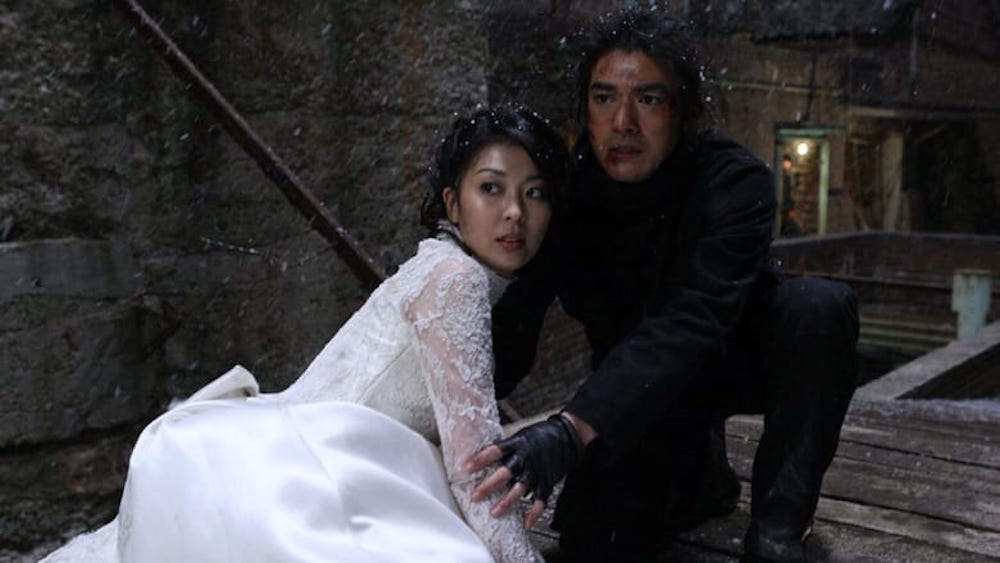By Chlotrudis Independent Film Society
Rating: 4.2 cats
Director: Shimako Sato
Starring: Kanata Hongo | Takako Matsu | Takeshi Kaga | Takeshi Kaneshiro | Tôru Nakamura | Yuki Imai

Original language title: K-20: Kaijin niju menso den
Country: japan
Year: 2009
Running time: 137
IMDB: http://www.imdb.com/title/tt1156395/
Jason says: “Even if 2009 weren’t one of the most disappointing summer movie seasons in recent memory, I’d still wish that more foreign popcorn films got released here. I know subtitles can be a tough sell for movies aimed at a broad audience and dubbing can make even a great movie look terrible, but there’s got to be some way to put a fun-for-the-whole-family adventure movie like K-20 in front of audiences that could appreciate its constant invention.
“The invention starts from the first minute, when we hear a radio broadcast dated 8 December 1941, announcing… That Japan has signed a peace treaty with the United States and United Kingdom. Imperial Japan never falls, and as we open in 1949, there’s a rigid class system still in place in the city of Teito. Master criminal K-20 (Kaijin Niju Menso Den, ‘The Fiend with Twenty Faces’) tweaks the upper class, who devour coverage of Kogoro Akechi (Toru Nakamura), the police inspector assigned to catch K-20. A mysterious man hires poor circus acrobat Heikichi Endo (Takeshi Kaneshiro) to photograph Akechi’s engagement to Countess Yoko Hashiba (Takako Matsu), but that results in Endo being mistaken for K-20 and arrested. It becomes clear that the real K-20 has framed him, but why?
“The world of K-20 can be called retro-futuristic, steampunk, or any number of other things. It’s a world where police zeppelins serve as carriers for tiny whirlybird helicopters, Nikola Tesla and Thomas Edison shared a Nobel Prize, Tesla’s ideas for wireless transmission of energy may be turned into a weapon, and Heikichi’s friend Genji ‘the Gadget’ (Jun Kunimura) can build amazing things out of scraps. It’s a world out of the serials, akin to Sky Captain and the World of Tomorrow, although not quite so mannered in its attempts to evoke a ‘futuristic forties’ feel. The visual effects are maybe not quite so impressive as they might be in a similarly-conceived American picture, but they’ve got a consistent quality, and do their duty of impressing without overwhelming.
“Populating this world with a group of ejoyable characters helps quite a bit. Takeshi Kaneshiro makes for a fun accidental swashbuckler; I’m not sure what kind of actual martial arts skills he has, but he and his stunt doubles sell the acrobatics while also providing plenty of amusing slapstick as he trains to master K-20’s skills so that he can confront the man who framed him as an equal. He combines matinee idol looks with Jackie Chan charm. Takoko Matsu is a great leading lady for him; sure, we’re telegraphed everything we need to know about Yoko in her first scene (asking a maid if an arranged marriage is really all a woman can look forward to), but she throws herself into that role with gusto, whether gleefully ripping her expensive wedding dress apart, acting spectacularly ignorant of the lower classes’ living conditions, or being an excited accomplice later. She’s as charming here as she was in The Hidden Blade, and her giddiness often spreads to the audience. Toru Nakamura does a nice job of making Akechi just a bit insufferable, but not foolish or worthy of disdain.
“The rest of the cast is good, too: Young Yuki Imai avoids excessive mugging as Heikichi’s ‘kid brother’ Shinsuke, and Kanata Hongo hits the right notes as Akechi’s young assistant Yoshio. Jun Kunimura has a good Q vibe going as Genji, and plays nicely off Reiko Takashim as his wife. Writer/director Shimako Soto works the cast’s chemistry well, keeping things light between them. She doesn’t have them wink at the audience, but right up until Big Confrontation time, the general feeling is of fun, rather than high tension.
“That’s not to say K-20 is not exciting. It’s got a number of big action set pieces, including a highly creative escape, a couple clever break-ins, and a final showdown that is well worth the price of admission. The movie seems pitched for a family audience, and Sato keeps things pretty kid-friendly, keeping things at a manageable pace with most of the action being fairly bloodless even as it’s clearly laid-out. Even though there are plenty of effects, she never lets them overwhelm the characters. Naoki Sato contributes a booming, John Williams-esque score which adds to the excitement.
“That score makes me wonder if the production companies are looking for Western success (among other things – the print screened also had many of the main titles in English). Even if they don’t pull off the unlikely feat of cracking that market, we’ll hopefully get a sequel or two to import. After all, K-20 certainly beats a lot of the home-grown blockbusters. 4+ cats
“Seen 20 June 2009 at the IFC Center #1 (New York Asian Film Festival)”
